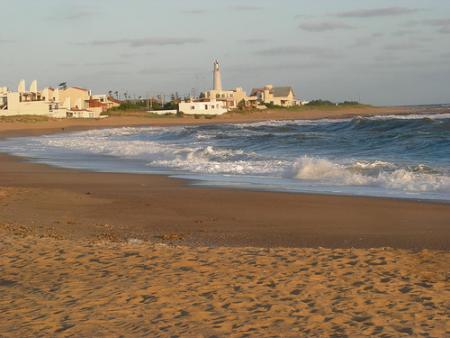The signature lighthouse is a dead giveaway…at least for anyone who’s traveled the Uruguayan coast between Punta del Este and the Brazilian border. While certainly not the only lighthouse in Uruguay, you’ll rarely see a photo of the town of La Paloma that doesn’t include this one.
Which tells us something about this old resort town’s heritage.
La Paloma is one of the oldest settlements in the region, because it was actually a port city many years before anyone was thinking of seaside resorts in the area. The first registered arrival was on January 9, 1520, when a Portuguese vessel anchored overnight while looking for a passage to the Pacific.
It wasn’t until 1874 that local officials decided to position La Paloma as a beach resort…or balneario as we call them in Uruguay. Accommodations in those years were sparse, as the only public place to stay was in the guest quarters of the lighthouse. The early wealthy tourists from Montevideo arrived by sailing ship; since there were no roads, and the railroad was still years away.
Ordinarily, these types of histories end by the writer describing a giant 21st century seaport that was born out of the humble beginnings of a place like La Paloma.
But that’s not the case here. The village of La Paloma, at less than 5,000 people, is not remarkably bigger than it was at the end of the 19th century.
But things are happening now.
Today’s La Paloma finds itself positioned as the centerpiece of Uruguay’s last section of mostly-undeveloped coastline….which is also easily Uruguay’s most-beautiful stretch of coast. The pristine beaches go on for miles, with fine white sand bordered by deep blue waters.
Instead of a dangerous sail or steamship journey from Montevideo, La Paloma is now only three hours from Montevideo’s airport on a fast highway.
And the area has not escaped the attention of the international developers who are on the lookout for the “next big thing”. Several of them are buying up large tracts of land near La Paloma, and a number of high-end developments are already in progress. They’re not highrises, but rather spacious country properties with large lots and tasteful homes.
Yet despite the flurry of nearby activity, the town of La Paloma retains its small-town feel. The main avenue through town is bright, colorful and cheerful. It offers several inviting restaurants, and a number of tasty barbeque parrilladas, as evidenced by the scent of wood smoke and grilling meats in the air around mid-day. Plenty of markets and shops are available to supply what you need.
All in all, it’s a fun, unpretentious atmosphere. And the property prices in town are also unpretentious.
You should know that La Paloma is fairly dead in the wintertime. I’ve been there twice in mid-winter, and while you’ll find the basics available, there’s not much open and not a lot to do.
But this upbeat town comes to life on holiday weekends, and really starts to bustle when things warms up in the springtime. With unbeatable weather from November through April, it’s the perfect complement to North American seasons.
So if you’d like to enjoy the sandy beaches and warm waters—but want to forgo the glitz of a large resort in favor of a small town feel—then La Paloma may be just right for your second home in the southern hemisphere.

